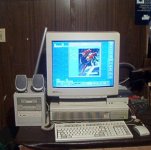Starshadow
Experienced Member
Hi, i'm a noob  . Someone gave me this awesome old HP-UX system, a HP Apollo 735/99 with 128 mb ram and a drive box with a CD-Rom, 3.5 floppy drive and Tape Drive.
. Someone gave me this awesome old HP-UX system, a HP Apollo 735/99 with 128 mb ram and a drive box with a CD-Rom, 3.5 floppy drive and Tape Drive. 
I'm trying to get this thing to recognize the cd-rom( ultimate goal is to install a web browser and get the old battlewagon online, and give it something other than one of the stock wallpapers) i think this old beast is running HP-UX version 9.
Any ideas on how to mount a disc( its a little different from Linux) or if theres specific CD-Rom drive that work best, etc?
I'm trying to get this thing to recognize the cd-rom( ultimate goal is to install a web browser and get the old battlewagon online, and give it something other than one of the stock wallpapers) i think this old beast is running HP-UX version 9.
Any ideas on how to mount a disc( its a little different from Linux) or if theres specific CD-Rom drive that work best, etc?





